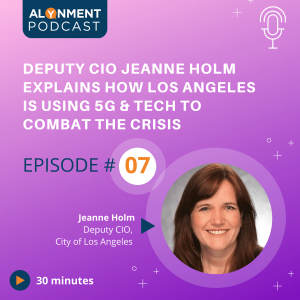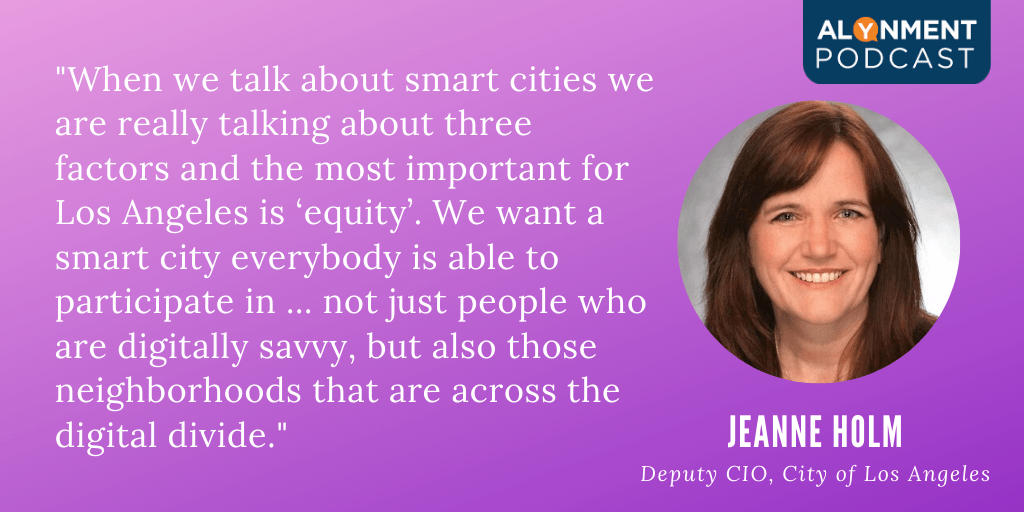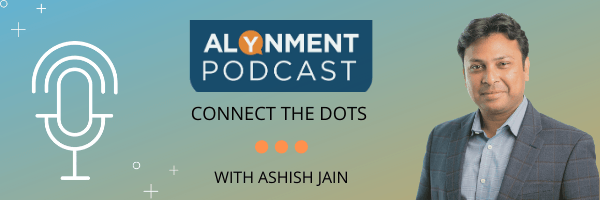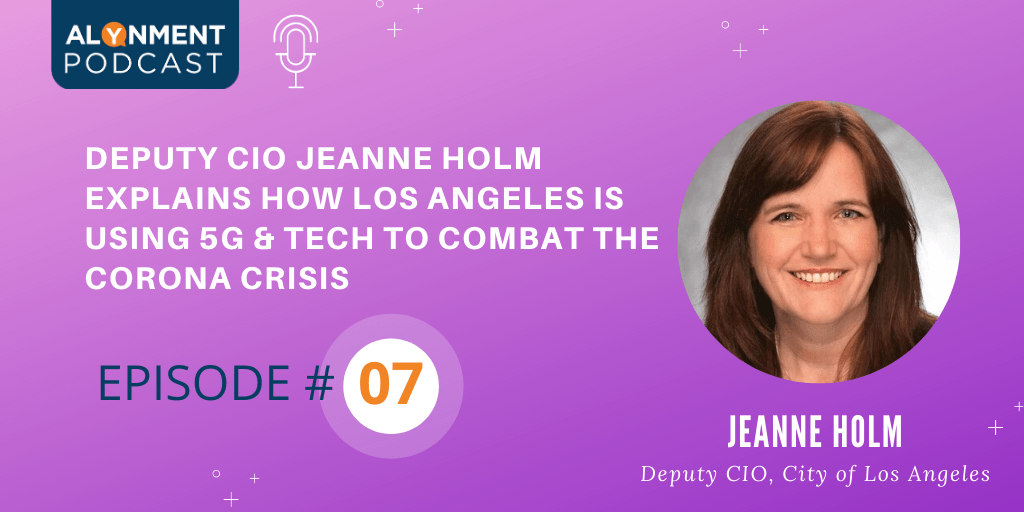Smart cities are the wave of the future, and rapid urbanization is driving the need for the latest technologies, like 5G, IoT, and AI, to connect every aspect of a city’s operations. But a true smart city improves the quality of life for citizens and raises its economic competitiveness. Los Angeles is one of the four cities to launch 5G, but has it made any difference to improve its digital economy? Let’s find out.

Jeanne Holm is the deputy CIO of the City of Los Angeles and the Senior Technology Advisor to the Mayor. While she has played an instrumental role in helping the city launch many technology initiatives, including 5G, her overall accomplishments are far more impressive.
Jeanne’s experience includes partnering with global governments to build robust open data ecosystems. She served as the Chief Knowledge Architect at NASA and was twice awarded the NASA Exceptional Service Medal for leadership. She has received multiple awards for her work on the Galileo and Voyager space programs and three Webby’s from the International Academy of Digital Arts and Sciences.
She’s also a fellow of the United Nations International Academy of Astronautics, a distinguished instructor at UCLA, and leads several startups on education and social justice. She’s one of the “Top 50 Women in Tech”, with more than 130 publications on information systems, knowledge management, and innovation.
Dr. Holm believes that the current situation is really one in which a lot of people find uncertainty and really don’t know what to do. And as we move forward from a city’s perspective, we really want to help people know the right things to do to keep people safe and the right things to do to keep the economy going at the same time.
HOW DOES IT FEEL TO ACHIEVE SO MUCH IN LIFE AND HOW DO YOU DO IT?
I don’t feel that I’ve achieved that much. I feel that we were put here to be of service to each other, and I have been honored to be able to do that service as part of the federal government and now the local city government. I’m always honored to work with amazing people all over the world, whether it’s during the Ebola outbreak in Sierra Leone or working on open government data in Russia or working at the White House with President Obama on creating data.gov. I’ve just been honored to be able to work with amazing people with really brave innovation ideas.
HELP US UNDERSTAND THE ROLE OF A DEPUTY CIO OF L.A. AND SENIOR TECH ADVISOR.
So day today, I sort of live in two worlds. In the CIO’s position as the deputy, I oversee a variety of infrastructure operations: help desk and emergency operations which are released very prevalent and impertinent right now, the 311 call center. There are three television stations managed the City of Los Angeles, and social media as well as our Google Suite, which has been very front and foremost during this COVID crisis as we move people to telework. And then I also have a citywide Data and Predictive Analytics Group that we were able to build these past few years that looks at really interesting data transit analysis across the city and the Data Science Federation that brings 18 Universities together with 88 cities to create new ideas around data science for cities.
On the Mayor’s side, I get the opportunity to work with all kinds of city departments, looking at everything from urban air mobility and autonomous flying vehicles to robotics, to drones, to data analysis for how we are approaching the COVID crisis. There’s a whole variety of amazing challenges that cities face, many of which are the same from city to city.
WHAT DOES ‘SMART’ MEAN FOR THE CITY OF L.A.?
When we talk about smart cities, we are really talking about three factors, and the first and most important for Los Angeles is ‘equity’. We want a smart city to be one that everybody is able to participate in and everybody gets the benefits, not just people who are digitally savvy or very connected, but also those neighborhoods that are across the digital divide. Secondly, we want to make sure that a smart city is efficient. We have a public trust to use taxpayer dollars in the best way possible to provide city services, from trash pickup to clean streets to the environmental impact on climate change. We want to make sure that we’re doing that in the best and most efficient way possible. The third one is really around the economy. We want to make sure that we’re becoming a smart city that is, one, focused on developing new economic avenues for people, and that includes people who may be coming up out of the digital divide. We’re talking about STEM (Science, Technology, Engineering, Math) careers, new ways of education. Secondarily, we are looking for fostering innovation for startups and existing businesses in Los Angeles to do new things around issues like 5G and so we have a variety of incubators and innovation labs that have grown up around the city.

WHAT WAS YOUR RATIONALE TO CONSIDER 5G AS A TECHNOLOGY CHOICE FOR LA, AND HOW HAS IT WORKED OUT SO FAR?
It’s been transformational. We looked at the issues around 5G as an opportunity. A lot of cities approach this as a challenge, like how are we going to work with telecommunications companies to put this in and it’s not simple to do. You have to rip up streets, you have to lay fiber and generally hang these off of streetlamps. There’s a variety of things that are part and parcel of this. What we saw, back in 2017, was that this the way for the future, and we really needed to embrace it as a new opportunity. We formed connectivity and digital inclusion working group that worked across about 14 different City of Los Angeles departments, looking at issues around things like the aesthetics of 5G, what kind of streetlights could have attachments to them. We looked at the permitting process, and at an excavation. I’ve learned more about different asphalt types in the last three years than I ever thought I would. What it did is that it really let us get ahead of the curve, and we really worked with public/private partnerships with our telecommunications companies and met with them frequently to understand what it was that they needed to be business-friendly for them. They really needed things to happen fast and they needed things to happen cheaply. We were able to figure out a way to speed up our permitting process 25 times. We used to permit two streetlight attachments a week, now we permit 50.
That was a lot of streamlining and amazing work from the bureau of street lighting and the bureau of engineering to really focus in on that aspect. We are one of the most economical cities in which to attach a 5G device just because you have so many streetlights. We have 225,000 streetlights. For us, the cost and management of those are not so expensive on an individual basis. Our attachment rate is relatively competitive.
In exchange, though, we needed something from the telecommunications companies, and it goes back to that aspect I talked about, which is most important to Los Angeles, which is ‘equity’. We wanted to be able to fix a problem that happened in the past when we didn’t govern the deployment of 3G and 4G. In that case, we ended up with a city where neighborhoods did not have easy access or affordable access to the internet. In some of our neighborhoods, less than 50% of homes are connected to the internet. Now in the COVID-19 environment, those kids are trying to learn from home and get online, and they can’t. So we decided with 5G, we would share maps, GIS (Geospatial Information System) maps around our digital equity areas in the city. We worked with the telecommunication companies, and they’re building out faster in those neighborhoods than they have traditionally in the past, so that at the end of our 5G deployment, we’re going to have a much more equitable city.
IN THE CURRENT SITUATION WHEN EVERYONE IS WORKING FROM HOME OR GETTING EDUCATION FROM HOME, IS 5G HELPING THEM CONNECT?
It is! Let me give you an example. Before we started the 5G deployment, the city of Los Angeles had about 1,500 3G and 4G devices that were out in the community. Now we already have 2500 and we’re on our way to 5 to 10,000. With the densification of the network that 5G requires because they’re just putting a lot more bandwidth out, the devices have to be closer to each other. We’re finding ways to build out neighborhoods where we didn’t before, so kids are able to get online. And we also just launched a new website called “Get Connected Los Angeles” that integrates a whole bunch of offers from our telecommunication companies and others for giving kids super low-cost access to computers as well as free or super low-cost Internet. So, it’s free for families with kids in K through 12. It’s free for health care providers, and it’s free for educators.
YOU WERE TALKING ABOUT 1500 AVERAGE NUMBER OF DEVICES IN A SINGLE COMMUNITY OR THE CITY?
In the city. Overall Los Angeles is a pretty big city, over 500 square miles, four million people, and 500,000 businesses. When 3G or 4G networks were built, companies rationally built those out for profit. They built them along with areas of the most profitable neighborhoods, the highest economic development businesses. What we realized is that other areas got left behind. As a city, we don’t really have the funds to create an entire network across all of Los Angeles. That would cost something in the neighborhood of $9 billion. And so instead, what we’ve been doing is leveraging our relationship with the telecommunication companies to help give them what they wanted, which was speed and cost in exchange for building out coverage in these neighborhoods that had been left behind in the past.
WHEN YOU’RE SAYING DEVICE, DOES IT REALLY MEAN BASE STATIONS TO PROVIDE CONNECTIVITY IN NEIGHBORHOOD?
Right, they are small cells for 5G or their antennas because we have both wireline and wireless. The wireless you get on your phone is the wireless cellular access that comes off large antennas, and those are gently squirreled away in our parks or easements around the city.
HOW ELSE HAS TECHNOLOGY INITIATIVES LIKE 5G, IOT OR ANYTHING ELSE THAT YOU’VE LAUNCHED IN THE PAST OR ARE CURRENTLY LAUNCHING IS HELPING YOU IN A SITUATION LIKE COVID-19?
Let me start internally focused just on the City of Los Angeles. We have 48,000 employees at the City of Los Angeles, and clearly some of those jobs can’t be done virtually. We can’t virtually pick up the trash, fix a pothole, remove graffiti, put out a fire, or do policing. So a large number of our positions have to physically still be in the city and in public areas. But a large number of our city’s support can actually be done virtually. We’ve been able to move more than 13,000 people of the City’s employee population into a completely virtual environment and another 10-12,000 into an environment that runs off of our Google suite that we have at the City. That lets about half our workforce work virtually during this time. My organization that runs the three TV stations we have and the Mayor gets on every night, it’s always about safer at home. We want to practice what we preach and keep people at home, but still conducting the business of the City. As part of that, we’re making sure that they have the ability to securely access applications, to be able to virtually run public meetings because we’re very much about open and transparent government and we want people to be able to make public comments at those meetings to replicate as much as possible the world we were in a month ago – it seems like it’s been longer – where people are able to just have that ease of interaction and ease of transparency.
DO YOU THINK THIS IS THE NEW NORM; ADAPTING TO THE VIRTUAL AND WORK FROM HOME, DOING THINGS REMOTELY? DO YOU THINK BUSINESSES AND GOVERNMENT OFFICES, IN GENERAL, ARE GOING TO ADOPT THIS MODEL OR ADOPT IN SOME PARTS OF OPERATIONS?
Virtual work has been around for a long time. I’ve watched a variety of organizations work to embrace this. First at NASA, then the White House, the World Bank, and then at the City. Some organizations are very virtual just by their nature. The World Bank has a lot of people who are in-country, and so a lot of the work gets done virtually, which is part of the culture there. To a certain extent, NASA was forward-facing in this, too. But a lot of organizations, like in the City, where things are normally face-to-face, so managers learned and have a culture of ‘I need to see somebody at a desk to know that they’re working’. We’ve been really working hard on that culture change, and it’s really about change management in getting people comfortable with the fact that people could be productive and even more productive at home. A year ago, I decided that I would try to virtualize our 311 call center, which is one of the areas that I oversee. It’s a very stressful job, and I know because the people in those positions log in every second, where they’re at because they are on the system answering calls. We have about 4000 calls a day that we answer. As a result, I was very confident in knowing that if they were working, and I could see that. But we allowed people to work from home. About 60% of our call center normally works from home. For us that was simple to virtualize the rest of the employees. It also provided a road map for the City to say, “Look, we know people will be productive at home”. In fact, in some cases, productivity increased when people started working from home, and morale certainly increased. What we wanted to do was use that as the trailblazer for the rest of the City to say to the managers, “People are going to get their jobs done. They’re all hardworking and sincere people. Trust them to do the work and then trust the Information Technology agency to be able to provide the security tools to get that work done.”
DO YOU THINK IT IS LESS ABOUT THE TECHNOLOGY AND AS YOU SAID THE WORK ‘TRUST’ TO GET THING DONE FROM HOME?
I just have to say I am really amazed and really happy to see that so many people at the City of Los Angeles are stepping up and forward into this challenge as a way of helping each other. We in L.A. call ourselves the “city family,” and it’s very much that kind of a feeling where we’re all worried about everybody staying healthy but we are also very focused on making sure that all the city’s services continue to run while doing this massive lift to help people to telework while doing a massive lift to getting information and data analysis around COVID-19. It’s been really interesting watching the fact that given the empowerment and freedom for people to make the best choices at the moment that we’re actually seeing the very best of people step forward.
IS THERE ANYTHING THAT YOU THINK FROM A TECHNOLOGY PERSPECTIVE, HAD THIS NOT BE DONE I COULDN’T HAVE DONE IT IN COPING WITH THIS SITUATION
There are two kinds of things that come to mind when you ask that question. One is being able to get people online that we talked about. We have a couple of programs that I’ll just mention in that space. One is called ‘R-Cycle LA’, which is a computer giveaway program for low-income families. We teach kids in the neighborhood how to refurbish old computers, and then we improve those computers and give them to families. We also buy new Chrome books for folks as well. The second one is called ‘Tech to go’, which is a program out of our public libraries, where you can go and obviously check out a book but you can also check out a computer, a tablet, or a Wi-Fi hotspot. You can get training at the libraries on how to use these devices. You can also check it out for a month. It’s really a powerful way for people to get a chance to try out the technology. When a kid in high school is looking at colleges, he can now have free Internet access for a month while he’s got that Wi-Fi device and really be able to make a much better decision and create a much better application. Those are interesting ways in which we’ve been taking this opportunity of building out a more robust, equitable broadband network across the city with 5G. Secondly, there’s this other opportunity with COVID-19. I mean, it’s hard to imagine anything positive coming out of this, but our city recently won a grant from NASA for $2 million around air quality, called “Predicting what we breathe”. It’s really using artificial intelligence and machine learning to combine satellite data with IoT data. So, the Internet of things data from our sensors on trash, drugs, streetlights, and traffic lights all across the city that collect air quality data. We have a bunch of partners from the healthcare industry and the South Coast Air Quality Management District. What we’ve realized is, as we started this work and doing predictive analytics to try to improve health outcomes, we have this strange opportunity where suddenly a massive amount of human activity on the planet has stopped as everybody isolates and quarantines. The ability to study what happens when the environmental systems do a very quick reset is really interesting, because then what we can do is we can measure what happens before and after an intervention. Originally, we look at things like tree planting. What happens when you plant trees and the tree canopy becomes mature versus an area where you don’t plant trees in or other things like that. Now we can actually look at what happens when you make an entire city into a pedestrian area. What happens when you stop traffic on the highways? How can a city change policies to have a dramatic impact on the environment that will improve air quality and mitigate climate change?
HAVE YOU ALREADY NOTICED THE CHANGE IN AIR QUALITY NOW THAT EVERYONE IS INSIDE AND THE CARS ARE NOT ON ROADS?
It’s dramatic! We saw this first happening in China a couple of months ago, in January, when they started having a lot of closures and people were staying home. A lot of the manufacturing was stopping, then we’re seeing it sweeping across the United States now, as cars are off the streets and there’s very little traffic. I’ve lived in Los Angeles my whole life. I’m a third-generation Angelino. I’ve never seen the freeways all green. It’s amazing! But at the same time, it’s amazing because we have this horrible situation in which we’re trying to keep each other safe. When we see these dramatic shifts in human activity for whatever reason, we’re now able to say what would happen if we did that even on a smaller scale or on a neighborhood scale? How would that improve the quality of air say around the port of Los Angeles or the airport?
To your earlier point, if it turns out that we are able to get change management to happen in organizations that let people be trusted to telework and do that more effectively. It improves morale, it’s likely to improve productivity, and it certainly improves the environment. So these are things we may learn out of this tragedy that can make some things better.
WHAT KIND OF CHALLENGES DID YOU FACE IN PICKING UP ROLLING ON 5G IN THE CITY AND WHAT WOULD YOU TELL OTHER CITIES IN TERMS OF HOW THEN CAN BETTER PREPARE?
There were a few challenges. Like shifting the internal mindset a bit from the way in which we have been doing things in a 3G and 4G world, the number of permits we issue, the processes we did, the expectations of how we would interact with telecommunication companies. We needed to shift that into a very different mindset in which we basically assume that telecom companies would be able to find a way to work more positively with us; not see each other as adversaries but really see each other as partners. They needed us in the streets and the permits and streetlights to get their job done, while we need it to be able to solve this problem we’ve had from the past ungoverned spaces where we had a digital divide across the L.A. By solving those things hand in hand, we’re both much happier. The best evidence is that L.A. became the first 5G city because we were so business-friendly, and at the same time we’re building out digital equity in neighborhoods that have never been able to connect in the past.
The thing that I would share with other cities is really to approach this as an opportunity instead of a problem to be solved. The opportunity varies a little bit. Some cities have used this to basically lay a municipal infrastructure and broadband network which they wanted to do or to connect city buildings together by being able to ride on the conduit that the telecommunication companies are putting in. It’s an opportunity to fix digital divide issues. It’s an opportunity potentially to help with education. We were able to negotiate with Verizon to bring in computer labs to 12 of our local middle schools that use 5G technology and business incubators around gaming and entertainment for 5G. There are opportunities in all of this that cities can really capitalize on if they just think differently about the approach.
It has paid off for us because there’s already 5G technology infrastructure. It’s not complete across the entire city yet. We’re still building it out with them, but because we already have that infrastructure, it was much easier for those telecommunication companies to step forward with really amazing opportunities for school kids, healthcare workers, and educators for free internet during this time because they already have the infrastructure here. If we have been still fighting with them or resistant to 5G, we wouldn’t have that capability where they would be able to make those offers.
I hope everyone out there just stays safe and healthy. I appreciate everything that everyone is doing to try to make that happen.
It’s amazing how the City of L.A’s investment in 5G connectivity and digital infrastructure is helping them not only bridge the digital divide but also developed digital equity. Their forward-looking vision and openness to collaborate with technology innovators and network operators have certainly prepared them well to combat the unprecedented crisis like COVID-19.


